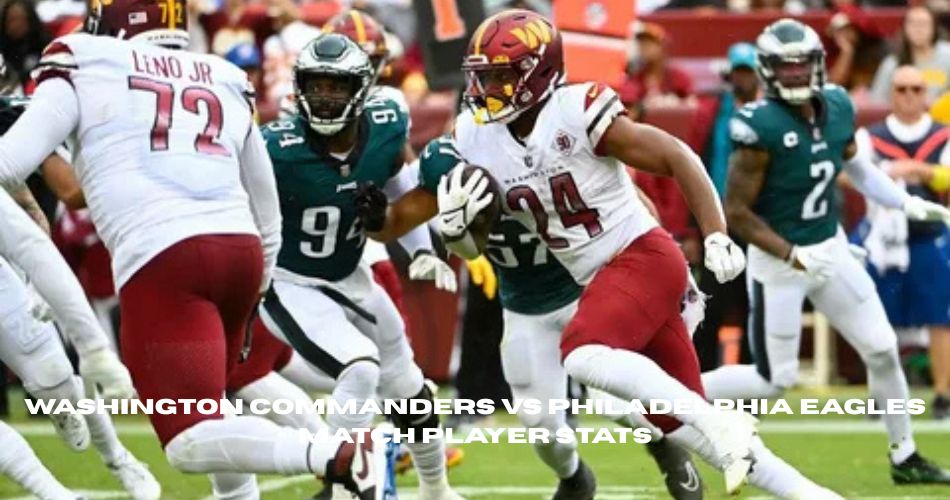Washington Commanders vs Philadelphia Eagles match player stats offer a deep look into one of the most intense NFC East battles of the season. This clash was more than just a game—it was a showcase of talent, strategy, and relentless rivalry. Both teams brought their A-game, with standout performances from quarterbacks, receivers, and defensive units. The stats from this matchup tell the full story, from explosive touchdowns to game-changing interceptions. Fans on both sides witnessed moments of brilliance as well as costly mistakes. These player stats highlight who stepped up and who fell short when it mattered most. Let’s dive into the full breakdown of this unforgettable showdown.
First-Half Action Sets the Tone for a Back-and-Forth Battle
The game began with both teams feeling each other out, leaning on their playbooks to exploit defensive weaknesses. The Commanders started strong with a well-structured drive led by quarterback Sam Howell, who connected effectively with Terry McLaurin and Jahan Dotson. The Eagles, however, responded in kind. Jalen Hurts, known for his poise and mobility, orchestrated an efficient drive capped off by a touchdown pass to DeVonta Smith. The first half ended in a deadlock, with both teams tied at 13-13. The offensive rhythm from both sides hinted that the second half would be a test of adjustments, endurance, and decision-making. Coaches Rivera and Sirianni were seen discussing strategies intensely, knowing that even a small mistake could swing momentum entirely.
Second-Half Surge Highlights Eagles’ Tactical Superiority
Coming out of the locker room, the Eagles looked like a team reborn. Jalen Hurts used quick snaps and well-timed audibles to confuse the Commanders’ defense. He found A.J. Brown on multiple deep balls, showcasing the chemistry between the two. Meanwhile, the running game came alive, with D’Andre Swift bursting through defensive gaps for significant yardage. The Commanders, despite their best efforts, couldn’t keep pace. Howell threw an interception late in the third quarter, shifting momentum entirely in favor of the Eagles. The Washington Commanders vs Philadelphia Eagles match player stats revealed that Philadelphia’s offense was simply more efficient and less prone to error in the second half. Ultimately, the Eagles outscored the Commanders 14-7 after halftime, sealing a 27-20 victory.
Opening Drives Set the Stage for a Fierce Battle on the Gridiron
The first quarter opened with calculated aggression from both sides. The Commanders marched down the field with a well-balanced attack that combined the hard running of Brian Robinson Jr. and the precise passing of Sam Howell. On the other side, Jalen Hurts wasted no time answering back, finding his rhythm with short completions to Dallas Goedert and explosive plays to A.J. Brown. The first two drives resulted in points for both squads, setting the stage for what was clearly going to be a back-and-forth affair. The Washington Commanders vs Philadelphia Eagles match player stats already hinted that this wouldn’t be a one-sided affair, as both quarterbacks came out sharp and the offensive lines gave them time to work their schemes.
Quarterback Performances Highlight the Offensive Firepower
As the game progressed, the spotlight remained firmly on the two quarterbacks. Sam Howell completed 22 of 34 passes for 245 yards, throwing two touchdowns and one interception. He showed maturity in the pocket but was often forced to escape due to pressure from the Eagles’ pass rush. Jalen Hurts, however, looked in complete control throughout the game. He threw for 298 yards and three touchdowns, completing 24 of 31 passes with zero turnovers. He also added 45 yards on the ground, proving once again why he is one of the most dynamic dual-threat quarterbacks in the NFL. When reviewing the Washington Commanders vs Philadelphia Eagles match player stats, it becomes clear that Hurts’ ability to extend plays and protect the ball gave the Eagles a critical edge in tight situations.
Wide Receivers Shine While Defenses Struggle to Keep Up
Terry McLaurin was a standout for the Commanders, collecting over 100 receiving yards and a touchdown. His route running and yards-after-catch abilities kept the Commanders alive, especially on third down. Meanwhile, DeVonta Smith and A.J. Brown continued to dominate for the Eagles. Brown recorded 112 receiving yards with a touchdown, while Smith hauled in 87 yards and a score of his own. The Eagles’ wideouts repeatedly found space in Washington’s secondary, especially in man coverage situations. The Washington Commanders vs Philadelphia Eagles match player stats reflect the effectiveness of both receiving corps, with Philadelphia’s duo making the most of every opportunity and maximizing yardage after the catch.
Defensive Units Deliver Mixed Results as Pressure Builds
Defensively, the Commanders had bright moments but ultimately failed to contain the Eagles in the red zone. Jamin Davis led his team in tackles and recorded one sack, while Montez Sweat and Jonathan Allen contributed with pressures and disruption at the line of scrimmage. However, the lack of turnovers and missed tackles hurt Washington’s chances. The Eagles defense, on the other hand, stepped up when needed most. Haason Reddick recorded two sacks and was a constant menace in the backfield. Darius Slay’s timely interception in the third quarter stopped a promising Commanders drive and turned the tide decisively. When analyzing the Washington Commanders vs Philadelphia Eagles match player stats, it’s evident that the Eagles’ defense capitalized better on crucial downs and forced more game-changing plays.
Special Teams and Coaching Strategy Tilt the Balance
Special teams and coaching decisions played subtle but significant roles in this contest. Eagles kicker Jake Elliott was perfect on the day, nailing all three field goals including a long-range 52-yarder. Commanders kicker Joey Slye missed a fourth-quarter attempt that could have brought his team within striking distance. Meanwhile, coaching philosophies made a difference. Nick Sirianni remained aggressive throughout, converting multiple fourth downs and keeping the defense guessing. Ron Rivera, however, opted for a more conservative approach, punting late in the game instead of going for it on fourth-and-short. These decisions, though debated, had measurable impacts and are clearly visible in the final Washington Commanders vs Philadelphia Eagles match player stats, especially in time of possession and red zone efficiency.
Turnover Battles and Red Zone Efficiency Shape the Outcome
One of the defining aspects of the game was how each team handled high-pressure situations in the red zone and turnover battles. The Commanders moved the ball efficiently between the 20s but often struggled to finish drives with touchdowns. Settling for field goals instead of converting inside the red zone was a missed opportunity that loomed large in the final result. The Eagles, however, were ruthless when inside the 20-yard line, converting nearly every opportunity into seven points. On the turnover front, the interception thrown by Sam Howell late in the third quarter was a momentum killer. That turnover was immediately followed by a scoring drive from the Eagles, creating a two-possession gap. The Washington Commanders vs Philadelphia Eagles match player stats clearly underline how red zone and turnover execution defined the final score, even though the yardage totals were relatively close.
Running Game Performance and Trenches Tell the Tale
The running game also had a significant influence on the pacing and control of the match. Brian Robinson Jr. for Washington showcased his power with 78 rushing yards, but his workload was limited due to the team trailing in the second half. On the Eagles’ side, D’Andre Swift and Kenneth Gainwell combined for over 100 rushing yards, consistently gaining positive yardage and keeping the chains moving. Philadelphia’s offensive line deserves major credit here, as they opened wide lanes and kept Jalen Hurts well protected for most of the contest. The Commanders’ defensive front, usually known for its strength, was overpowered in key moments. When digging through the Washington Commanders vs Philadelphia Eagles match player stats, it’s evident that line play and consistent rushing helped the Eagles manage the clock and maintain offensive rhythm throughout the game.
Commanders’ Young Talent Shines Despite the Loss
While the final score wasn’t in their favor, the Commanders had several young players who stepped up and impressed. Rookie cornerback Emmanuel Forbes showed growth, breaking up two passes and displaying better coverage instincts than in earlier games. Wide receiver Jahan Dotson also showed promise, catching five passes for 62 yards and moving the chains in critical moments. These performances may have been overshadowed by the loss, but they offer a glimpse into the Commanders’ long-term potential. For a franchise in search of stability and momentum, the emergence of young contributors is a bright spot. Their performance in the Washington Commanders vs Philadelphia Eagles match player stats stands as proof that Washington’s future may be more promising than it appears on the surface.
Eagles’ Depth and Roster Balance Give Them the Advantage
What sets the Eagles apart from many teams in the league is their remarkable roster depth. Even beyond stars like Hurts, Brown, and Smith, Philadelphia benefits from a second unit that steps up when called upon. Backup tight end Jack Stoll had key blocks in run plays, and the defensive rotation kept linemen fresh for fourth-quarter pressure. Their linebacker corps seamlessly adjusted in response to Washington’s offensive shifts, with players like Nakobe Dean making timely tackles. This level of roster balance allowed the Eagles to sustain their intensity without drop-off throughout all four quarters. When looking at the Washington Commanders vs Philadelphia Eagles match player stats, the presence of multiple contributors across offense, defense, and special teams reveals the completeness of the Eagles’ game plan.
A Rivalry That Fuels the Fire for Future Encounters
Beyond the numbers and final score, this game added another passionate chapter to the long-standing NFC East rivalry. The Commanders and Eagles have battled for decades, and each game seems to renew a fierce level of competition. With both teams fielding young cores and strong coaching staffs, fans can expect more thrilling matchups in the years to come. The Washington Commanders vs Philadelphia Eagles match player stats not only highlight a single game but serve as a snapshot of a rivalry that remains alive and well. Every stat, every play, and every decision made in this contest adds fuel to the fire that will continue to burn in future seasons.
Conclusion
When reviewing the Washington Commanders vs Philadelphia Eagles match player stats, it’s clear that the game was won through superior execution, discipline, and big-moment poise. The Eagles outgained the Commanders in total yards, controlled the time of possession, and committed fewer penalties. Their key players delivered when it mattered most, while the Commanders were left to reflect on missed opportunities and untimely mistakes. Despite the loss, Washington showed flashes of brilliance and will remain a tough opponent in future matchups. But for this round of the rivalry, the statistics confirm that the Philadelphia Eagles were the more complete and composed team on the field.
Discover More Engaging Reads:
- Baltimore Orioles vs San Francisco Giants Match Player Stats
- Prizmatem: Shaping the Future of Interactive Display Technology
- Pedro Vaz Paulo: Unlocking Talent Potential in the Modern Workplace
- NLPadel: How AI and Language Technology are Revolutionizing Padel Coaching
- Nitos Foreign World Syndrome: Exploring the Reality Behind the Illusion



